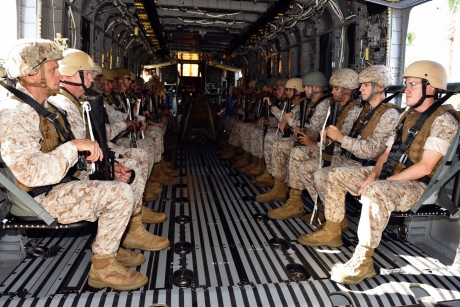The Sikorsky CH-53K Super Stallion heavy-lift helicopter is being developed by Sikorsky Aircraft to replace the CH-53E helicopter of the US Marine Corps (USMC). The USMC plans to acquire 200 CH-53K helicopters.
CH-53E Super Stallion
 CH-53E Super Stallion
CH-53E Super Stallion
In 1967 the US Marine Corps issued a requirement for a heavylift transport helicopter with a lifting capacity 1.8 times that of the CH-53D. The Sikorsky developed S-80 helicopter to meet this requirement. It evolved from the earlier Sikorsky S-65 (H-53 Sea Stallion) mainly by adding a third engine and a larger rotor system. A fuselage was stretched by 1.88 m. The S-80 prototype made its first flight in 1974. Since then it was the largest and most powerful helicopter outside Russia. Initial production contract was awarded in 1978. This helicopter was adopted by US Marine Corps as the CH-53E Super Stallion in 1981. The “CH” designation stands for “Cargo Helicopter”. The Super Stallion saw its first shipboard deployment in 1983. A total of 227 machines were built and 180 of them are still in service. Currently the Super Stallion is the largest and heaviest helicopter used by the US military. The CH-53E is expected to remain in service until 2025.
US Marines are using these helicopters to deliver troops, vehicles and supplies from ships to shore. US Navy acquired a small number of these helicopters for shipboard resupply. Also US Navy uses a dedicated minesweeping version.
This helicopter can carry 37 troops. With centerline seats installed the Super Stallion can carry 55 soldiers. Alternatively it can carry cargo with a maximum weight of 13.6 t internally and 14.5 t on external load. It is capable of lifting LAV-25 armored vehicle or M198 155 mm field howitzer with crew and ammunition. It can recover aircraft up to its own size.
The Sea Stallion is operated by a crew of 5, including 2 pilots and a combat crew of 3 gunners. During peacetime it is flown only by 2 pilots.
 CH-53E upgraded glass cockpit – Image: helis.com
CH-53E upgraded glass cockpit – Image: helis.com
| Country of origin | United States |
| Entered service | 1981 |
| Crew | 2 – 5 men |
| Dimensions and weight | |
| Length | 30.2 m |
| Main rotor diameter | 24 m |
| Height | 8.46 m |
| Weight (empty) | 15.07 t |
| Weight (maximum take off) | 33.3 t |
| Engines and performance | |
| Engines | 3 x General Electric T64-GE-415 turboshafts |
| Engine power | 3 x 4 380 shp |
| Maximum speed | 315 km/h |
| Cruising speed | 278 km/h |
| Service ceiling | 5.64 km |
| Range | 1 000 km |
| Ferry range | 1 833 km |
| Payload | |
| Passengers | 37 / 55 men |
| Internal payload | 13 600 kg |
| External payload | 14 500 kg |
| Armament | |
| Machine guns | 2 x GAU-15/A, 1 x GAU-21 |
Ch-53E source military-today.com
The Super Stallion can be fielded from amphibious assault ships for the transportation of personnel and equipment. It will also be used to carry external cargo loads. The aircraft can be operated from austere and remote forward operating bases.
 Size comparison CH-53E vs CH-53K
Size comparison CH-53E vs CH-53K
The new helicopter will feature improved payload, range, and hot-high capabilities. It is expected to deliver reliable and cost-effective, low-maintenance and survivable solutions in all conditions.
Key performance parameter
A key performance parameter of the heavy-lift platform is its ability to perform its primary mission—carrying heavy stuff over long distances—in the thinner air created by high elevations and hot temperatures, or “high/hot” conditions, said Col. Hank Vanderborght, program manager for the H-53 Heavy Lift Helicopters Program Office (PMA-261) at Naval Air Systems Command (NAVAIR).
The CH-53K is required to carry 27,000 pounds in cargo from a sea-level base where the temperature is 103 degrees to a landing zone that is 110 nautical miles away and 3,000 feet above sea level where it is 91.5 degrees. Such conditions comprise the standard “Navy high/hot day,” in which the CH-53E only is capable of carrying 9,000 pounds.
“It’s awesome. The thing is a beast,” Vanderborght said of the King Stallion. “The Echo is an incredibly powerful helicopter as it is, the most powerful that we have in the U.S. military. The K is going to make the Echo look like a toy.”
That step up in power is necessary after a decade of war in which the U.S. military has retrofitted its vehicles and gear with heavy armor and weapons to counter emerging threats like roadside bombs and insurgent ambushes. A CH-53E pilot by trade, Vanderborght noted that when he first started lifting Humvees in the 1990s, they weighed between 5,500 and 8,500 pounds depending on the version. Source navalaviationnews.navylive.dodlive.mil
The USMC’s much needed replacement for the notoriously unreliable CH-53E Super Stallion heavy-lift helicopter has had its fair share of issues. But now as the CH-53K accelerates its flight testing, its price tag is what’s most concerning—costing a projected $122 million per helicopter. Yes, this is nearly the same unit price as the F-35B, the Joint Strike Fighter variant intended to replace the Marine Corps Harriers and and hundreds of their Hornets. Source thedrive.com
CH-53K King Stallion Flight Testing Begins Transition to Patuxent River Naval Air Station: Here
Excerpt
PATUXENT RIVER, Md., July 5, 2017 /PRNewswire/ — Lockheed Martin (NYSE:LMT) today announced the CH-53K King Stallion program has successfully completed its first extended “cross country” flight from Sikorsky’s West Palm Beach, Florida, facility to Naval Air Station Patuxent River, Maryland. This is the first of several such flights that will occur during 2017 and 2018 as the CH-53K flight test program transitions to the flight test facilities at Patuxent River (PAX).
CH-53K programme and development details
Sikorsky secured a $3.5bn system development and demonstration (SDD) contract from the US Department of Defense in April 2006, for the development, systems integration, production of test helicopter, and testing and evaluation of the helicopter.
Rockwell Collins was awarded a contract in June 2006 to provide an avionics management system for the CH-53K helicopter.
 Image: defenceindustrydaily.com
Image: defenceindustrydaily.com
In December 2006, GE Aviation was selected to provide three GE38-1B turboshaft engines. Hamilton Sundstrand was selected to provide an auxiliary power unit (APU), environmental control system (ECS) and the main engine start system consisting of an air turbine starter and start control valve.
Sikorsky selected a Fuselage Team in May 2007 to design and build the major fuselage sections of the helicopter. The team consists of Aurora Flight Sciences, EDO Corp, GKN Aerospace, and Spirit AeroSystems.
Sikorsky CH-53K Fuselage Supplier Team
 Image: helis.com
Image: helis.com
Sikorsky’s Fuselage Team will consist of Aurora Flight Sciences, EDO Corp., GKN Aerospace, and Spirit AeroSystems. They were selected following an extensive solicitation and evaluation of multiple bids over a 12-month competition. Source helis.com
The first APU light-off test was conducted in August 2010. The CH-53K prototype aircraft is expected to perform its maiden flight in late 2014.
A new facility was opened at the Florida Assembly and Flight Operations (FAFO) campus, in March 2011, to perform CH-53K’s experimental assembly line operations. Assembly of the CH-53K Ground Test Vehicle (GTV) began in June 2011 and the first GTV prototype was delivered in December 2012.
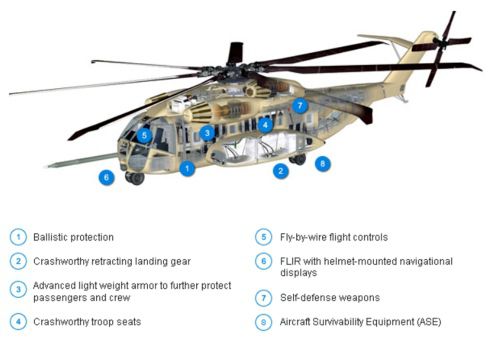
A total of seven prototype helicopters will be built and delivered during the system design and development programme. The four prototypes will be deployed as engineering development vehicles, while the other three will serve as dedicated ground test vehicle, static test article and fatigue test platform.
The Naval Air Systems Command (NAVAIR) placed a $435m contract with Sikorsky in May 2013 to build four production-representative CH-53K helicopters, designated as System Demonstration Test Articles (SDTA), for the USMC. The deliveries are scheduled to conclude in March 2017 and the initial operational capability is planned for 2019.
Spirit AeroSystems was awarded a $60m contract in June 2013 to provide major structural cockpit and cabin components for the SDTA aircraft.
In October 2013, Kratos Defense & Security Solutions received an $8.5m contract to design and develop maintenance training systems.
 Image: defenceindustrydaily.com
Image: defenceindustrydaily.com
Northrop Grumman Systems Corp awarded $25M contract for Phase II of the Defensive Electronic Countermeasures Suite Upgrade for the CH-53K: Here
Excerpt
Northrop Grumman Systems Corp., Rolling Meadows, Illinois, is being awarded $25,036,119 for cost-plus-fixed-fee task order 0512 against a previously issued basic ordering agreement (N00019-15-G-0026) for Phase II of the Defensive Electronic Countermeasures Suite Upgrade for the CH-53K.
AN/AAQ-24 Large Aircraft Infrared Countermeasures Systems
 The sensor turret of Northrop Grumman’s AN/AAQ-24 large aircraft infrared countermeasure (LAIRCM) deployed on a U.S. Marine Corps CH-53 Super Stallion helicopter. (Photo: Northrop Grumman)
The sensor turret of Northrop Grumman’s AN/AAQ-24 large aircraft infrared countermeasure (LAIRCM) deployed on a U.S. Marine Corps CH-53 Super Stallion helicopter. (Photo: Northrop Grumman)
The LAIRCM (Large Aircraft IR CounterMeasures) has been developed to protect US large aircraft from IR guided man-portable surface-to-air missiles. It is a derivative of the proven AN/AAQ-24 Nemesis Directional IR CounterMeasure (DIRCM) system. LAIRCM uses missile warning system to detect and incoming missile, then the protection system directs a pointer-tracker to the missile’s seeker jamming it with a IR laser energy beam.
The system is a fully autonomous system not requiring inputs coming from the aircraft crew. LAIRCM is being offered to the commercial aviation segment as a protection mechanism against any potential terrorist attack using man-portable, shoulder-launced surface-to-air missiles. Source: deagel.com
AN/APR-39D(V)2 Radar Warning Receiver/Electronic Warfare Management System
 Northrop Grumman
Northrop Grumman
The Northrop Grumman APR-39D(V)2 Radar Warning Receiver (RWR)/Electronic Warfare Management System (EWMS) is being designed to maximize survivability by improving aircrew situational awareness via interactive management of all onboard sensors and countermeasures. The APR-39D(V)2 will merge the C(V)2 baseline with the Northrop Grumman Digital Receiver product line, providing advanced RWR capability for today’s and tomorrow’s RF threat environment. The system will feature the latest technology in a small, lightweight configuration that protects a wide variety of fixed-, rotary- and tilt-wing aircraft from today’s most modern threats. Source: northropgrumman.com
AN/ALE-47(V) Countermeasures Dispensing System

In response to automated warnings of radar, infrared, laser and other threats against aircraft, the AN/ALE-47 Countermeasures Dispenser System (CMDS) both assists the crew in staying aware of the threats, and managing the deployment of electronic warfare devices that operate externally to the vehicle.[1] “Electronic”, in this context, covers enemy sensors across the electromagnetic spectrum. Electronic defense includes, as well as receivers and computers that detect and analyze threats, both countermeasures that are part of the aircraft, but also expendables that are released from it.[2]
In other words, it both acts as an electronics countermeasures suite controller and as an electronic warfare expendables dispenser. It replaces the AN/ALE-39. Alternatively, it can be controlled by other control systems, such as the AN/ALQ-213.
These expendables include radar-reflecting chaff, infrared countermeasures to confuse heat-seeking missile guidance, and disposable radar transmitters. In addition to active and passive countermeasures, expendables now include sensors for both electronic support, electronic warfare, and other intelligence functions such as chemical weapon detection using materials MASINT. In addition to the truly expendable items usually released as cartridges, a modern dispenser system will control towed decoys that lure radar- and infrared-guided missiles that avoid the other countermeasures. Source: citizendium.org
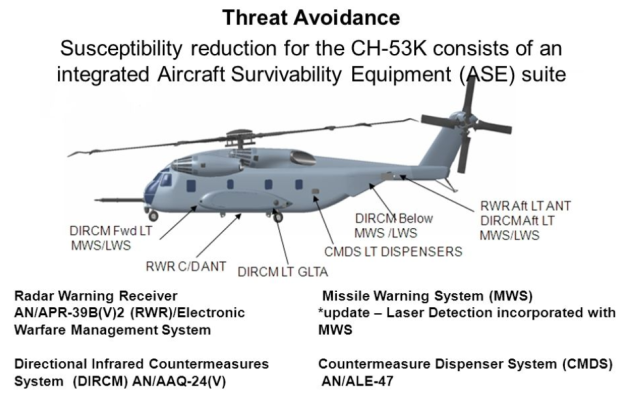
Design and features of CH-53K
The CH-53K will employ tip-to-tail technology in a new hybrid composite airframe for additional payload and range capability. The fuselage will incorporate lightweight armour and crashworthy retractable landing gear.
Energy-absorbing strut
 The tail of the CH-53K features an energy-absorbing strut. – Source verticalmag.com
The tail of the CH-53K features an energy-absorbing strut. – Source verticalmag.com
The helicopter will feature elastomeric main rotor head integrating 10ft long fourth generation rotor blades with advanced airfoils, upgraded engine system, cargo rail locking system, external cargo handling enhancements, and enhanced ballistic protection and survivability systems.
Elastomeric main rotor hub
 The CH-53K has an elastomeric main rotor hub and new composite rotor blades, which eliminate the pressurized spar found in earlier CH-53 models. – Source verticalmag.com
The CH-53K has an elastomeric main rotor hub and new composite rotor blades, which eliminate the pressurized spar found in earlier CH-53 models. – Source verticalmag.com
Composite main rotor blades
 Image: sikorskyarchives.com
Image: sikorskyarchives.com
Machine is fitted with next-generation composite main rotor blades. Blades are folded automatically. These are the largest and most advanced blades Sikorsky has ever produced. Source military-today.com
Composite flexbeams tail-rotor component
The operational goal is a three-fold increase in external load-carrying capacity, to more than 27,000 lb/12,247 kg over a mission range of 110 nautical miles/204 km. The extended payload capacity will be partially enabled by composites that include 35-ft/10.7m long fourth-generation rotor blades and a new, hybrid metal-composite airframe, which the OEM, Sikorsky (Stratford, Conn.), claims is more than 75 percent composite.
One of the enabling composite structures is the flexbeam, a flight-critical tail-rotor component that attaches the spar, upper skin and lower skin in each rotor blade to the rear horizontal shaft. The structure, 64 inches long by 13.5 inches wide by 3 inches thick (1,626 mm by 343 mm by 76 mm), has a dogbone shape reminiscent of a tensile test specimen, but with a 9° twist along its axis. Source compositesworld.com
The maximum gross weight of the helicopter will be 33,566kg, whereas the maximum alternate gross weight will be 38,419kg.
CH-53K’s sponsons are slightly narrower
 The CH-53K’s sponsons are slightly narrower than the sponsons and “bat wing” auxiliary fuel tanks on the E model. – Source: verticalmag.com
The CH-53K’s sponsons are slightly narrower than the sponsons and “bat wing” auxiliary fuel tanks on the E model. – Source: verticalmag.com
Cockpit and cabin
The joint interoperable glass cockpit of the CH-53K will provide the operators with additional capabilities and situational awareness.

rockwellcollins.com
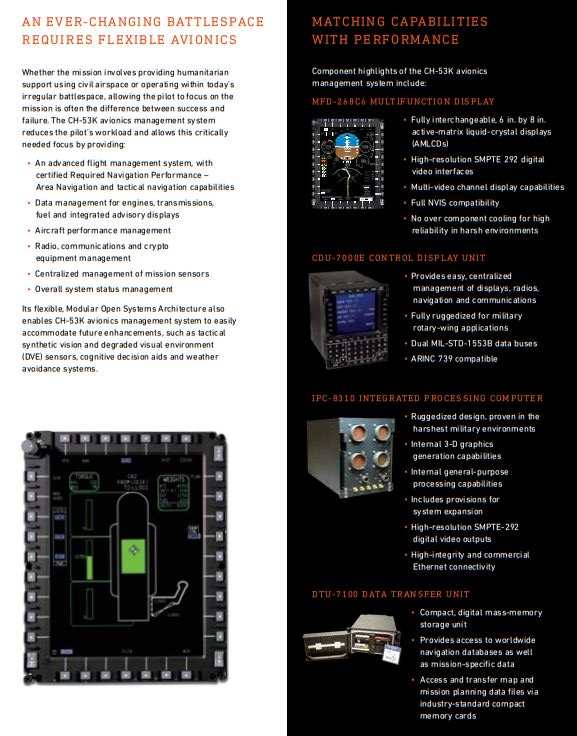
rockwellcollins.com
It will accommodate a pilot and a co-pilot, and three combat support crew members. It will be equipped with a fly-by-wire flight control system and improved electrical systems.
 The CH-53K’s windows have been enlarged to permit easier exit in an emergency, and its troop seats are fully crashworthy. Sikorsky Photo – Source verticalmag.com
The CH-53K’s windows have been enlarged to permit easier exit in an emergency, and its troop seats are fully crashworthy. Sikorsky Photo – Source verticalmag.com
The CH-53K will feature crashworthy seats for occupants. Its cabin measures 9.1m in length, 2.7m in width and 2m in height. The cabin area and volume will be 24.6m² and 9.1m³ respectively.
 CH-53K – Image: sikorskyarchives.com
CH-53K – Image: sikorskyarchives.com
Cabin area & payload capacity
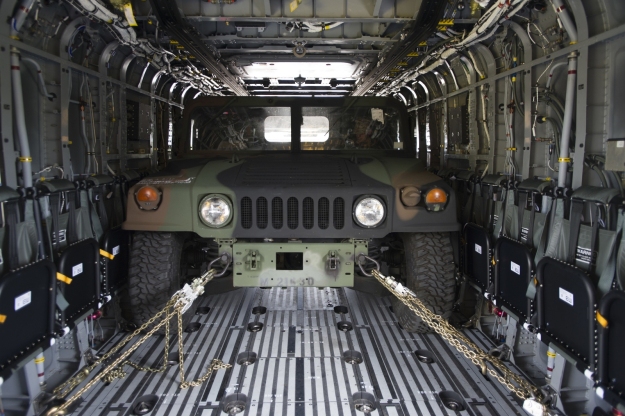 The CH-53K has a built-in winch and a wider cabin interior than its Super Stallion predecessor. Sikorsky Photo – Source: verticalmag.com
The CH-53K has a built-in winch and a wider cabin interior than its Super Stallion predecessor. Sikorsky Photo – Source: verticalmag.com
The CH-53K has a payload capacity of 15.9 t. The previous CH-53E with centerline seats installed can carry 55 soldiers. So the new helicopter should carry similar number of troops. The King Stallion has significantly increased lift capability over the previous Super Stallion. It can recover downed air vehicles. Also it can transport heavy weapons and vehicles externally. Source military-today.com
Avionics onboard CH-53K
The integrated avionics management system (AMS) of the CH-53K will provide advanced flight planning and navigation capability. It will be equipped with fully integrated active matrix liquid crystal multifunction displays, dual integrated processing cabinets, dual control display units and dual data transfer units.
The other equipment and systems will include a digital moving map, forward looking infrared (FLIR) system and electronic countermeasures. The AMS ensures the management of primary flight instrumentation, display systems, vehicle operational characteristics, civil and military flights and navigation and communication systems.
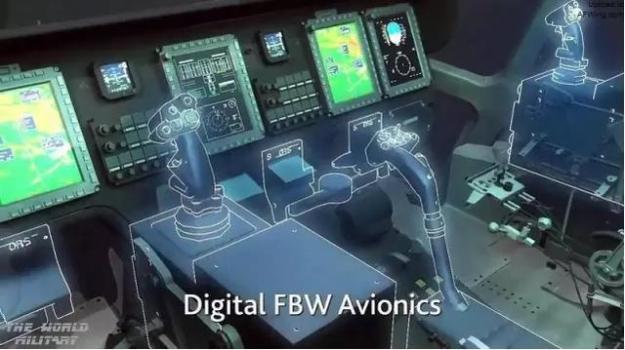
CH-53K Super Stallion Engine
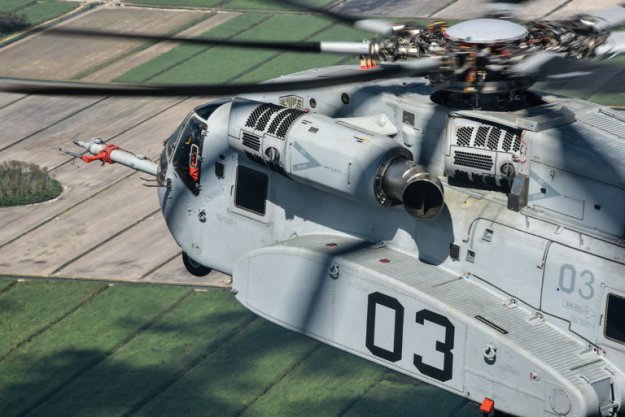 Image: verticalmag.com
Image: verticalmag.com
The CH-53K helicopter will be powered by three General Electric GE38-1B turboshaft engines controlled by a dual-channel Full Authority Digital Electronic Control (FADEC) system. The GE38-1B comprises a five-stage axial compressor mated with a single-stage centrifugal compressor. It is also equipped with an annular combustor, two-stage gas generator turbine, and three-stage power turbine.
The engines are rated at a maximum take-off power of 13,748kW and will ensure stall-free performance in all conditions.
GEA awarded $143.4M for CH-53K helicopter engines: Here
Excerpt
General Electric Aviation has been awarded a contract worth more than $143.4 million for the procurement of 22 low-rate initial production Lot 1 and 2 T408-GE-400 turboshaft engines for the CH-53K King Stallion helicopter.
General Electric GE38-1B (T408-GE-400) turboshaft
 3 × *General Electric GE38-1B turboshaft, * 7,500 shp (5,600 kW) each
3 × *General Electric GE38-1B turboshaft, * 7,500 shp (5,600 kW) each
The General Electric GE38-1B, designated the T408-GE-400 by the US Navy, is a turboshaft engine is based on the GE27 technology demonstrator and the US Navy’s T407 turboprop engine. GE27 served as the basis for the CFE738 commercial turbofan engine which powers the Dassault Falcon 2000 jet. Developing more than 7,500-shp at sea level the new engine is provided with a similar architecture to the popular T700 engine. General Electric’s main goals for the GE38-1B are: significant advances in engine performance, fuel efficiency and low life-cycle cost.

The GE38-1B has a five-stage axial compressor coupled with a single-stage centrifugal compressor. It has a low-emission, annular combustor, two-stage gas generator turbine, and three-stage power turbine. It features a dual-channel Full Authority Digital Electronic Control (FADEC) system with advanced health monitoring functions. The engine is highly resistant to sand erosion, salt-water corrosion and offers stall-free operation in all conditions – features ideal to withstand the Marine Corps’ tough operating environments.
 With improved fuel efficiency and maintainability, the CH-53K should be less expensive to operate than the CH-53E. “The 53 Echo is an expensive aircraft to fly,” said CH-53K chief designer Andreas Bernhard. “For the Marines, it is a serious burden and a hard decision on when do you send the 53 Echo, because it’s so expensive.” Source verticalmag.com
With improved fuel efficiency and maintainability, the CH-53K should be less expensive to operate than the CH-53E. “The 53 Echo is an expensive aircraft to fly,” said CH-53K chief designer Andreas Bernhard. “For the Marines, it is a serious burden and a hard decision on when do you send the 53 Echo, because it’s so expensive.” Source verticalmag.com
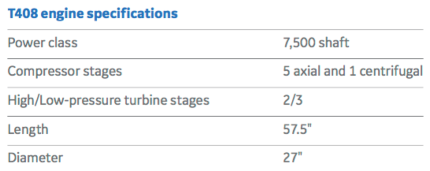
GE
To date, the GE38-1B engine has been selected to power the US Marine Corps’ CH-53K helicopter being developed by Sikorsky. CH-53Ks will supersede CH-53E helicopters which are powered by T64 engines. The GE38-1B features 60 percent fewer parts with longer component lives than its T64 predecessor. In addition, the new engine will offer excess power to meet current and future CH-53K mission requirements. Source deagel.com
Performance features of CH-53K
The CH-53K will have a maximum cruise speed of 315km/h and a maximum range of 841km. The helicopter will have hovering in ground effect ceiling of 2,902m, hovering out of ground effect ceiling of 969m, and one engine inoperative (OEI) service ceiling of 2,213m. The all engine operable service (AEO) ceiling of the helicopter will be 4,383m.
Sikorsky CH-53K Reaches 170 Knots During Testing: Here
 Image: sikorskyarchives.com
Image: sikorskyarchives.com
Excerpt
The 53K showed in testing conducted for the Marines in October of 2016 that it was capable of lifting a 27,000 pound load (12,200kgs) during a test flight lasting over 100 nautical miles. Among other tests performed, the 53K also reached a speed of 170 knots with power in reserve if and when needed.
Specifications (CH-53K)

* = data for K model. All others for E model.
Data from Sikorsky CH-53K sources, GE38-1B data, Flightglobal.com
General characteristics
| Number of Engines | 3 |
| Engine Type | T408-GE-400 |
| T408 Engine | 7,500 shp/5,595 kw |
| Maximum Gross Weight (Internal Load) | 74,000 lbs/33,566 kg |
| Maximum Gross Weight (External Load) | 88,000 lbs/39,916 kg |
| Cruise Speed | 141 knots/162 mph/261 km/h |
| Range | 460 NM/530 miles/852 km |
| AEO* Service Ceiling | 14,380 feet/4,383 m |
| HIGE** Ceiling (MAGW) | 13,630 feet/4,155 m |
| HOGE*** Ceiling (MAGW) | 10,080 feet/3,073 m |
| Cabin Length | 30 feet/9.1 m |
| Cabin Width | 9 feet/2.7 m |
| Cabin Height | 6.5 feet/2.0 m |
| Cabin Area | 264.47 feet2/24.57 m2 |
| Cabin Volume | 1,735.36 feet3/49.14 m3 |
* All Engines Operating
** Hover Ceiling In Ground Effect
*** Hover Ceiling Out of Ground Effect
Source dmitryshulgin.com
Armament
- Guns:
- 2 window-mounted .50 BMG (12.7 mm) M3M/GAU-21 machine guns
- 1 ramp-mounted .50 BMG (12.7 mm) M3M/GAU-21 machine gun
- Other: Chaff and flare dispensers
Armament source wikiwand.com
Main material naval-technology.com
Images are from public domain unless otherwise stated
Main image MarineCorpsAviationAssociation (flickr)
Revised Apr 01, 2017
Updated Oct 06, 2020






